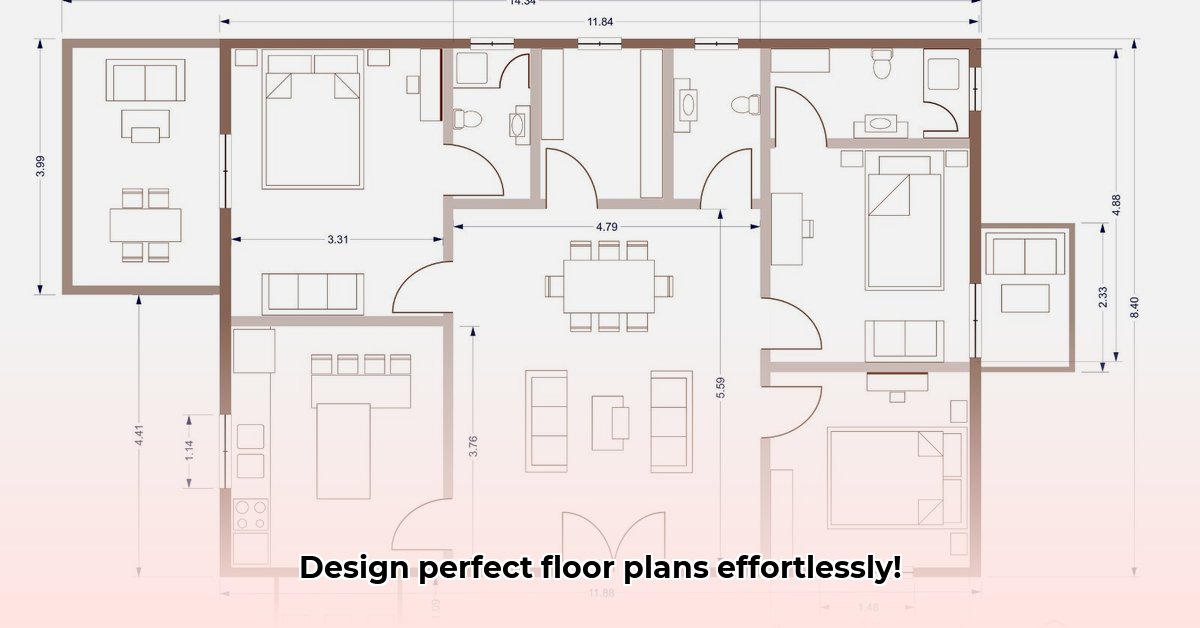Getting your measurements right is crucial for any home project, whether you’re planning a simple refresh or a complete renovation. With many floor plan software options available, choosing the right one can be overwhelming. This guide provides the necessary tools to succeed. We’ll compare top contenders – RoomSketcher, FloorPlanCreator, and Canva – highlighting their strengths and helping you choose the perfect fit. Whether you’re a DIY homeowner, a real estate agent, or a design professional, we’ll share tips and tricks for accurate measurements, avoiding costly mistakes, and bringing your project vision to life. For more on accurate measurements, see our guide on [floor plan dimensions](https://www.wavesold.com/floor-plan-dimensions-explained). Let’s find the perfect software for your next project!
Floor Plan with Measurements: Top Software Showdown 2024
Planning a home renovation, selling a property, or rearranging your furniture? Creating a floor plan with accurate measurements is key for construction and interior design. With so many software options, knowing where to start can be challenging. This review compares top contenders to help you find the perfect fit, focusing on features, ease of use, and price.
RoomSketcher: Accuracy and Detailed Design
RoomSketcher is a popular choice known for its detailed, accurate measurements. Its intuitive interface allows easy switching between metric and imperial units, dragging and dropping furniture, and visualizing spaces with 3D views. While the free version is basic, a paid subscription unlocks powerful features.
Pros:
- Highly accurate measurements minimize design errors.
- Seamless metric/imperial unit conversion ensures smooth project workflow.
- 3D modeling capabilities bring designs to life, enhancing client visualization.
Cons:
- Limited free version restricts design creation.
- Subscription costs can increase, especially for frequent users.
FloorPlanCreator: Mobile and User-Friendly
FloorPlanCreator excels as a mobile-first option, designed for speed and ease of use on the go. Its user-friendly interface suits even less tech-savvy individuals creating scaled drawings. While it may lack the advanced features of specialized software, the paid version offers access to more detailed plans and tools.
Pros:
- Excellent mobile accessibility enables floor plan design anywhere.
- Easy-to-use interface simplifies the design process for beginners and quick projects.
- Cross-platform compatibility allows seamless switching between devices.
Cons:
- Limited advanced features in the free version restrict detailed design aspects.
- Pricing for the paid version varies, impacting budget management.
Canva: Visual Appeal and Presentation
Canva shines with its versatility in creating visually stunning floor plans for presentations, marketing materials, or showcasing design ideas. Its intuitive drag-and-drop interface simplifies design. Although measurement precision might be less critical than in other applications, its design capabilities are unmatched if visual appeal is paramount. The paid version unlocks its true value, leveraging a full range of design tools.
Pros:
- Creates visually appealing, professional floor plans for marketing.
- Easy drag-and-drop interface ensures a user-friendly experience.
- Excellent design flexibility for marketing and presentations.
Cons:
- Measurement precision may not match dedicated floor planning software.
- The free version has limited features; the paid version’s usefulness depends on other design needs.
Feature Comparison: A Detailed Overview
Here’s a summary of the key differences:
| Feature | RoomSketcher | FloorPlanCreator | Canva |
|---|---|---|---|
| Measurement Precision | High | Medium | Low |
| 3D Modeling | Excellent | Basic | Limited |
| Ease of Use | Good | Excellent | Excellent |
| Mobile Friendliness | Fair | Excellent | Good |
| Collaboration Tools | Good | Limited | Limited |
| Pricing | Subscription | Subscription, Freemium | Freemium, Subscription |
Finding the Right Software for Your Needs
Choosing the best software depends on individual needs and budget considerations.
- Homeowners: Canva’s user-friendliness and aesthetic output are ideal for basic plans. RoomSketcher is a better investment if precision is critical for renovations.
- Real Estate Agents: Canva’s design strengths are suitable for quick, visually appealing plans. RoomSketcher offers highly accurate measurements.
- Interior Designers: RoomSketcher’s detailed features and professional 3D models justify the subscription cost.
Staying informed is key in the constantly evolving floor plan software landscape. Trying out the free versions of each software is the best way to determine which one meets specific workflow requirements. Carefully review pricing details before committing to a subscription or purchase.
How to Choose the Best Floor Plan Software for Real Estate Agents
Key Takeaways:
- Accurate floor plans are crucial for effective real estate marketing and client impressions.
- Software choices depend on budget, technical skills, and project complexity.
- Free options offer basic functionality, while professional tools provide advanced features.
- Consider ease of use, collaboration tools, and export options when selecting software.
- RoomSketcher often provides a balance of features and user-friendliness.
RoomSketcher: Balanced Features and User Experience
RoomSketcher is a strong contender, offering more power than free options but remaining less complex than professional-grade programs like AutoCAD.
- Pros: Intuitive interface, 3D rendering, export options, reasonable pricing.
- Cons: Advanced features may require a paid subscription; it might be overkill for simple floor plans.
FloorPlanCreator: Speed and Accessibility
FloorPlanCreator, with its browser-based platform, prioritizes speed and accessibility for generating fast marketing visuals.
- Pros: Simple to learn, quick turnaround, browser-based access.
- Cons: Lacks advanced features. 3D capabilities may be limited; it’s not ideal for detailed architectural plans.
Canva: Versatile Design Integration
Canva is a design powerhouse that allows floor plans and marketing materials to be designed together.
- Pros: Highly versatile, numerous templates, customizable, beautiful results.
- Cons: Requires another program to generate floor plans. Overwhelming for design software novices.
Considerations for Accuracy and Detail
When selecting floor plan software, consider the level of detail required, necessary 3D renderings, and the estimated number of plans needed. Prioritize user-friendliness, collaboration tools, and export options to streamline workflow and enhance client communication. By carefully evaluating these factors, real estate agents can choose the software that best aligns with their professional needs and budget, ultimately improving their marketing efforts and client satisfaction.
- Gray Kitchen Backsplash Ideas: Find Your Perfect Gray Tile - December 11, 2025
- Glass Wall Tiles For Bathroom: A Stylish, Durable Choice - December 10, 2025
- Glass Mosaic Kitchen Backsplash: Add Shimmer and Style - December 9, 2025









